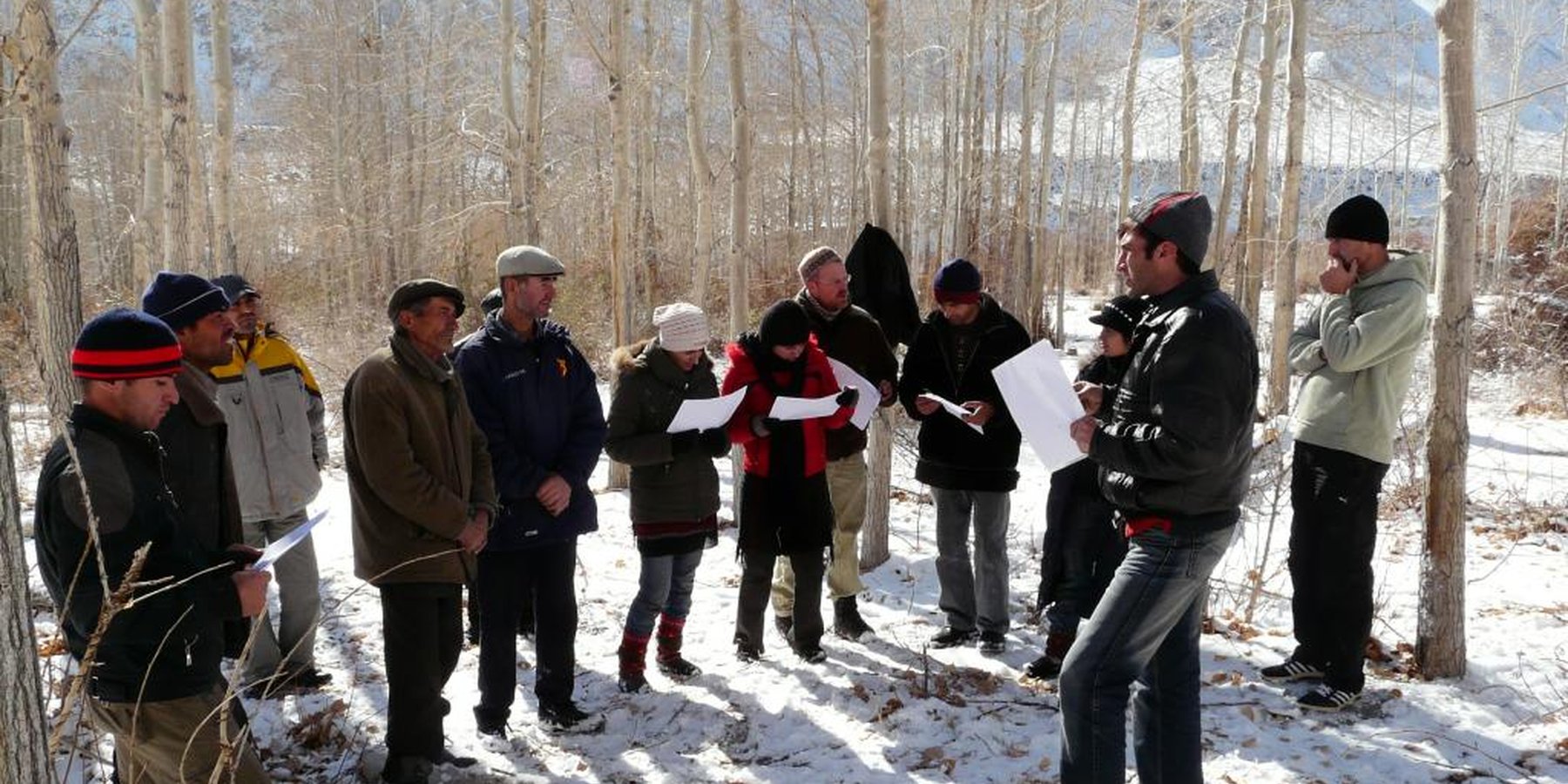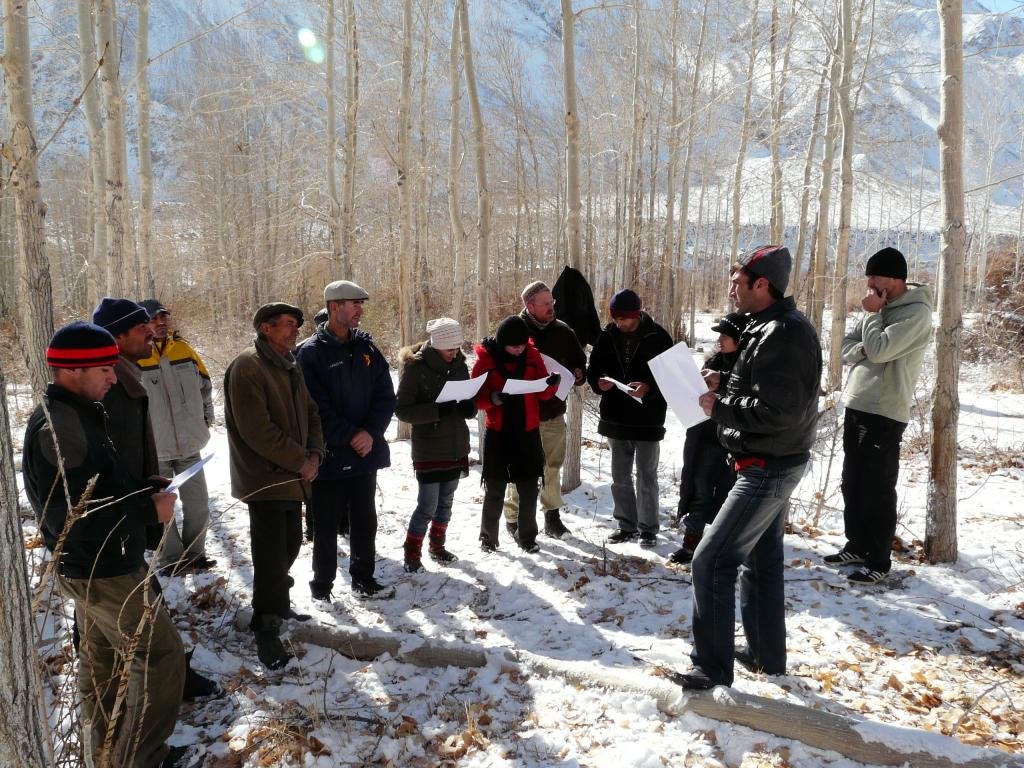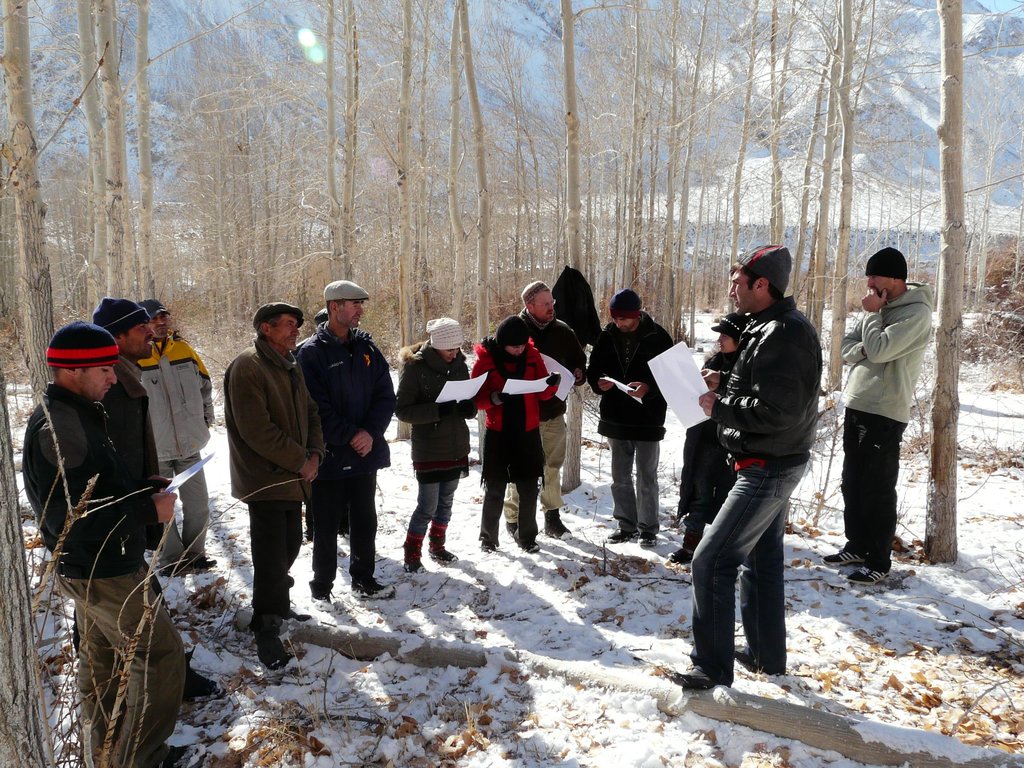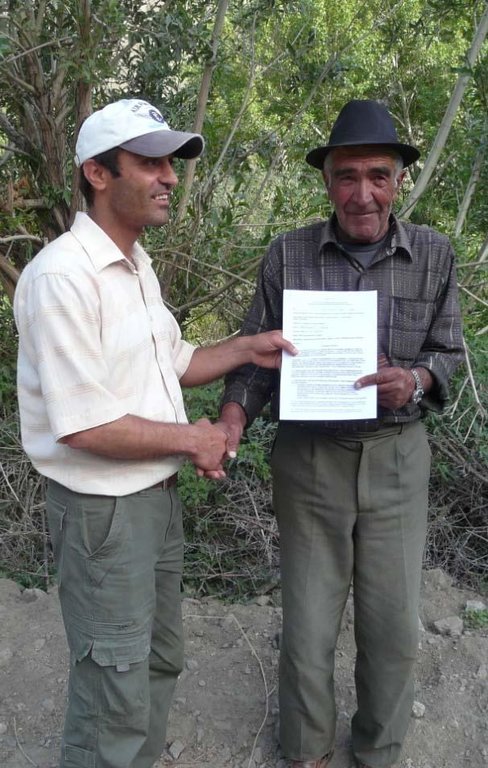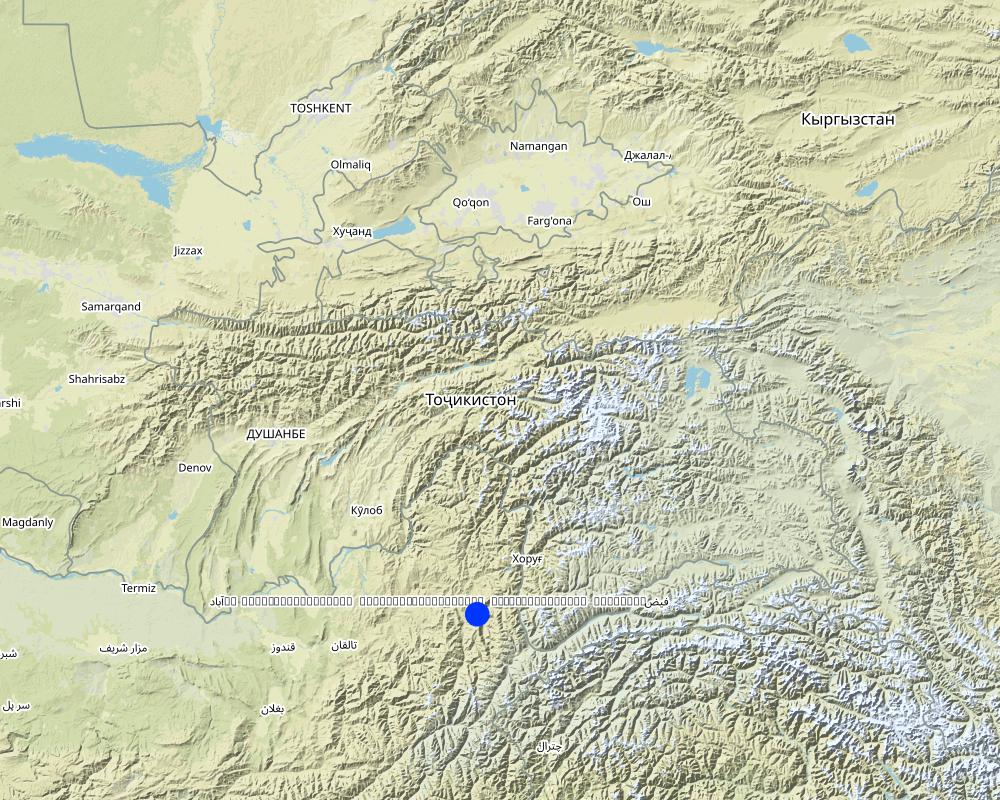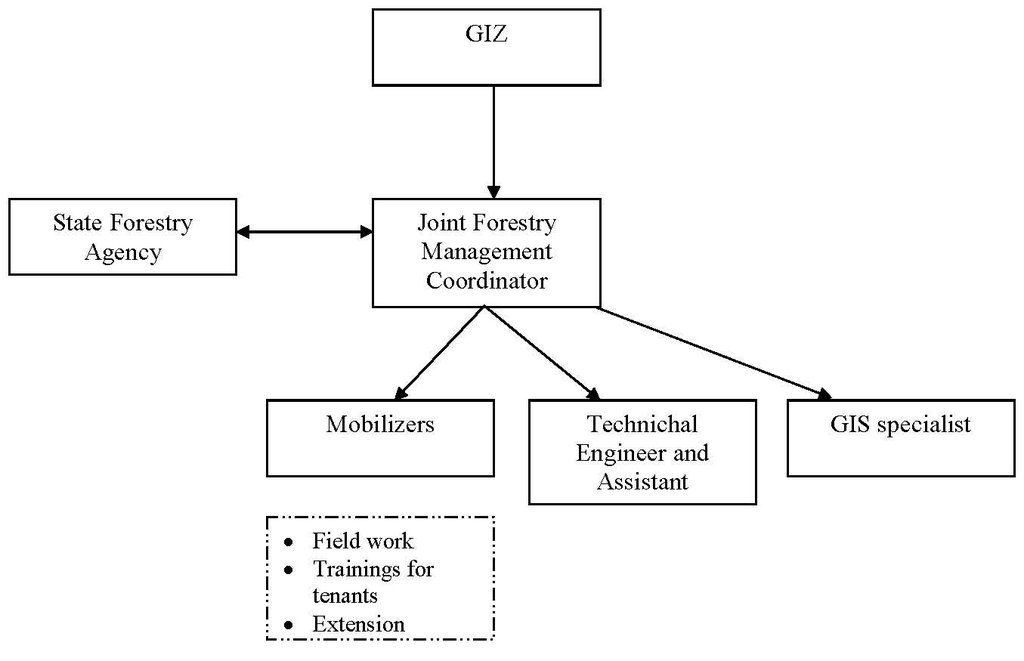Joint Forest Management (JFM) [ทาจิกิสถาน]
- ผู้สร้างสรรค์:
- การอัพเดท:
- ผู้รวบรวม: Roziya Kirgizbekova
- ผู้เรียบเรียง: –
- ผู้ตรวจสอบ: David Streiff, Alexandra Gavilano, Joana Eichenberger
Совместное управление лесами (СУЛ) (Russian)
approaches_2431 - ทาจิกิสถาน
ดูส่วนย่อย
ขยายทั้งหมด ย่อทั้งหมด1. ข้อมูลทั่วไป
1.2 รายละเอียดที่ติดต่อได้ของผู้รวบรวมและองค์กรที่เกี่ยวข้องในการประเมินและการจัดเตรียมทำเอกสารของแนวทาง
ผู้เชี่ยวชาญ SLM:
ผู้เชี่ยวชาญ SLM:
Angermann Michael
+992 935 747318
michael.angermann@giz.de
GIZ, Sustainable Management of Natural Resources in Gorno-Badakhshan
Okhonjon Str. 58-1, 736000 Khorog, Tajikistan
เยอรมนี
ผู้เชี่ยวชาญ SLM:
Neusel Benjamin
+992 935 747312
benjamin.neusel@cimonline.de
GIZ, Sustainable Management of Natural Resources in Gorno-Badakhshan
Okhonjon Str. 58-1, 736000 Khorog, Tajikistan
เยอรมนี
ผู้เชี่ยวชาญ SLM:
Kirchhoff Joachim F.
+992 44 6006702
joachim.kirchhoff@giz.de
GIZ, Regional Program on Sustainable Use of Natural Resources in Central Asia
Ayni Str./Nazarshoev Str., 734026 Dushanbe
เยอรมนี
ชื่อของโครงการซึ่งอำนวยความสะดวกในการทำเอกสารหรือการประเมินแนวทาง (ถ้าเกี่ยวข้อง)
Central Asian Countries Initiative for Land Management (CACILM I)ชื่อของโครงการซึ่งอำนวยความสะดวกในการทำเอกสารหรือการประเมินแนวทาง (ถ้าเกี่ยวข้อง)
Pilot Program for Climate Resilience, Tajikistan (WB / PPCR)ชื่อของโครงการซึ่งอำนวยความสะดวกในการทำเอกสารหรือการประเมินแนวทาง (ถ้าเกี่ยวข้อง)
Deutsche Gesellschaft für Internationale Zusammenarbeit (GIZ) GmbH (GIZ) - เยอรมนี1.3 เงื่อนไขที่เกี่ยวข้องกับการใช้ข้อมูลที่ได้บันทึกไว้ผ่านทาง WOCAT
วันที่เก็บรวบรวมข้อมูล (ภาคสนาม):
23/08/2009
ผู้รวบรวมและวิทยากรหลักยอมรับเงื่อนไขเกี่ยวกับการใช้ข้อมูลที่ถูกบันทึกผ่านทาง WOCAT:
ใช่
1.4 การอ้างอิงถึงแบบสอบถามเรื่องเทคโนโลยี SLM
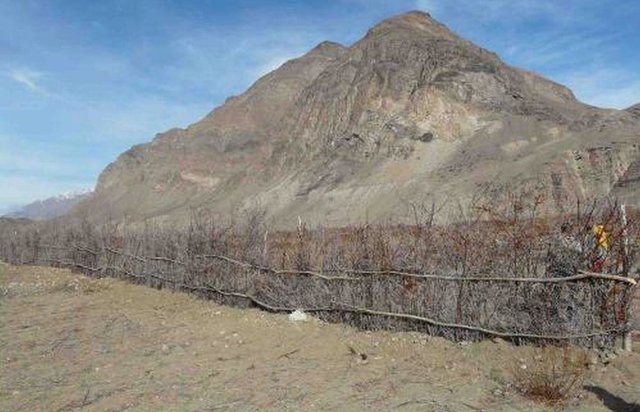
Establishment of living seabuckthorn fences for the protection … [ทาจิกิสถาน]
Protection of reforestation sites (willow, poplar and fruit trees) through living seabuckthorn perimeter fencing on Joint Forestry Management plots.
- ผู้รวบรวม: Roziya Kirgizbekova
2. คำอธิบายของแนวทาง SLM
2.1 การอธิบายแบบสั้น ๆ ของแนวทาง
Protection and rehabilitation of state forests based on joint long term agreements set up between the State Forestry Agency, and local forest users (in the frame of CACILM).
2.2 การอธิบายอย่างละเอียดของแนวทาง
การอธิบายอย่างละเอียดของแนวทาง:
Aims / objectives: In Soviet times, the Gorno Badakhshan Autonomous Region (GBAO) had been highly dependent on subsidised fuel for heating and cooking. After independence, as fuel could no longer be imported from the former Soviet Union, more pressure was exerted on the flood plain forests, leading to severe degradation of the resources through illegal felling and livestock grazing. The State Forestry Agency does not have the financial means nor adequate capacity to implement a sustainable forestry management system adapted to the changed political, socio-economic and ecological conditions. The main aim of this approach is the rehabilitation of degraded floodplain forests in collaboration with the local users. This can only be achieved, if local users can see that they will benefit from conserving and developing the forest. Also, the State Forestry Agency is supported in its restructuring and gets an opportunity to achieve the protection of the forest, and economic goals through forest products and income from the rented forest plots.
Methods: \'Joint Forest Management\' (JFM) means that governmental organisations and local users are involved in forest management on the basis of a contract with a duration of 20 years, valid under Tajik law, which defines the rights and obligations of all the parties. As a first step, and in order to ensure the protection of the plot, a fence has to be built to protect reforestation activities from livestock (see Technology TAJ366). Adequate irrigation of the forest areas is also supported. Forest tenants as well as Forestry Agency staff are also trained in sustainable forest management techniques. Progresses and challenges are regularly being monitored and technical advice is being given to forest tenants.
Stages of implementation: The implementation includes eight steps: (1) field check and meeting with village representatives, (2) information workshop, (3) general agreement with the whole community, (4) selection of tenants, (5) division of the plots, (6) signing of contracts with the individual tenants, (7) elaboration of management plans and annual plans for each tenant, and (8) monitoring of annual plans.
Role of stakeholders: The annual plan is based on a 5-year management plan for the respective plot. It determines the amount of work undertaken by the forest tenant as well as harvests and their shares to be obtained from the rented area in one year. The rental contract, the management plan, and the annual plan are mutually agreed on by the forest tenants and the Forestry Agency. Forest tenants develop a sense of ownership and responsibility for the sustainable use of forests and forest resources on their plot. The State Forestry Agency is responsible for control and technical advice.
2.3 รูปภาพของแนวทาง
2.5 ประเทศ ภูมิภาค หรือสถานที่ตั้งที่ได้นำแนวทางไปใช้
ประเทศ:
ทาจิกิสถาน
ภูมิภาค/รัฐ/จังหวัด: :
Tajikistan Gorno Badakhshan Autonomous Region (GBAO)
ข้อมูลเฉพาะเพิ่มเติมของสถานที่ตั้ง:
Ishkashim, Roshtkala, Shugnan
ความคิดเห็น:
This approach is currently implemented in the districts of Shugnan, Roshtkala and Ishkashim in GBAO, and each year, the area covered is gradually increasing.
Map
×2.6 วันที่เริ่มต้นและสิ้นสุดของแนวทาง
ระบุปีที่เริ่ม:
2009
2.7 ประเภทของแนวทาง
- ใช้โครงงานหรือแผนงานเป็นฐาน
2.8 เป้าหมายหรือวัตถุประสงค์หลักของแนวทาง
The Approach focused mainly on SLM with other activities (Income generation, income diversification, forest rehabilitation, improved access to forest resources)
Protection and rehabilitation of state forests based on joint long term agreements set up between the State Forestry Agency, and local forest users.
The SLM Approach addressed the following problems: Limited management and control capacities of the State Forestry Agency, combined with a sudden increasing need for firewood resulted in an uncontrolled 'open access' situation in the floodplain forests of GBAO. People were using forest resources in an unsustainable manner, including uncontrolled felling and livestock pasture. This resulted in a large scale degradation of the floodplain forest resources.
2.9 เงื่อนไขที่เอื้ออำนวยหรือเป็นอุปสรรคต่อการนำเทคโนโลยีภายใต้แนวทางนี้ไปปฏิบัติใช้
การมีไว้ให้หรือการเข้าถึงแหล่งการเงินและบริการ
- เป็นอุปสรรค
No funds available for the rehabilitation of irrigation infrastructure.
Treatment through the SLM Approach: Initial set up investments co-financed by international NGOs (GIZ).
การจัดตั้งระดับองค์กร
- เป็นอุปสรรค
No organisational structures for overall local management of rented state forests in place, including conflict solving mechanisms between stakeholders from different administrative levels.
Treatment through the SLM Approach: Establishment of Joint Forest Management council at local level.
กรอบแนวทางในการดำเนินการด้านกฎหมาย (การถือครองที่ดิน สิทธิในการใช้ที่ดินและน้ำ)
- เป็นอุปสรรค
User rights for state forest were exclusively with the State Forestry Agency. Locals used the forests illegally.
Treatment through the SLM Approach: Contracts with individual tenants providing them with long-term user rights and responsibilities.
The existing land ownership, land use rights / water rights greatly hindered the approach implementation The forest land is in State property, the State Forestry Agency has exclusive user rights, however open access leads to uncontrolled use of forest resources by the local people. Restricting access can help create clear regulations, but these are not always accepted by villagers who prefer illegal open access to natural resources.
ปริมาณงานที่ทำได้ กำลังคนที่มีให้
- เป็นอุปสรรค
After the collapse of the Soviet Union, the Forestry Agency had insufficient financial and human resources to manage the state forests.
Treatment through the SLM Approach: Responsibilities and workload are shared with the local population.
อื่นๆ
- เป็นอุปสรรค
The State Forestry Agency lacks finances and capabilities to manage forest resources.
Treatment through the SLM Approach: Support of the Agency for internal reforms and the introduction of a sustainable forest management scheme (JFM).
3. การมีส่วนร่วมและบทบาทของผู้มีส่วนได้ส่วนเสียที่เกี่ยวข้อง
3.1 ผู้มีส่วนได้ส่วนเสียที่เกี่ยวข้องในแนวทางนี้และบทบาท
- ผู้ใช้ที่ดินระดับท้องถิ่นหรือชุมชนระดับท้องถิ่น
Women and men, rich and poor are involved equally
Actual implementation in close cooperation with the other bodies
- ผู้เชี่ยวชาญ SLM หรือที่ปรึกษาการเกษตร
GIZ project staff and forest specialists
Supporting local users in implementing the Technology with some modifications.
The Approach has been designed by an international specialist, and some components by a local specialist
Conducting workshops, providing technical advice
- องค์กรพัฒนาเอกชน
International non-government
Coordination and financing of the project, design of the approach
- รัฐบาลระดับท้องถิ่น
Support during implementation
Cooperation, approval of the legal framework
- รัฐบาลแห่งชาติ (ผู้วางแผน ผู้ทำการตัดสินใจ)
Support during implementation
Cooperation, approval of the legal framework
ถ้ามีผู้มีส่วนได้ส่วนเสียหลายคนที่เกี่ยวข้องให้ระบุหน่วยงานตัวแทน:
GIZ
3.2 การเกี่ยวข้องของผู้ใช้ที่ดินระดับท้องถิ่นหรือชุมชนระดับท้องถิ่นในช่วงต่างๆของแนวทาง
| ความเกี่ยวข้องของผู้ใช้ที่ดินระดับท้องถิ่นหรือชุมชนระดับท้องถิ่น | ระบุผู้ที่มีส่วนเกี่ยวข้องและอธิบายกิจกรรม | |
|---|---|---|
| การริเริ่มหรือการจูงใจ | ปฏิสัมพันธ์ | Field visits, talks with village representatives, information seminar for the whole community. |
| การวางแผน | ปฏิสัมพันธ์ | 5-year Management Plans and 1-year Annual Plans are developed for each forest plot, jointly by the land users and State Forestry Agency staff. |
| การดำเนินการ | ปฏิสัมพันธ์ | Live fence construction, irrigation rehabilitation, sharing of harvest. |
| การติดตามตรวจสอบหรือการประเมินผล | ปฏิสัมพันธ์ | Completed via the close cooperation between the State Forestry Agency and GIZ, using interviews completed by project mobilisers, as well as monitoring of annual achievements. |
| Research | ไม่มี |
3.3 แผนผังแสดงขั้นตอนการทำงาน (ถ้ามี)
คำอธิบาย:
Organisational chart shows how the project staff work with the State Forestry Agency.
ผู้เขียน:
Sady Odinashoev (Tajikistan, Dushanbe)
3.4 การตัดสินใจเลือกใช้เทคโนโลยี SLM
ระบุผู้ที่ทำการตัดสินใจเลือกเทคโนโลยีมากกว่าหนึ่งวิธีไปปฏิบัติใช้:
- ผู้เชี่ยวชาญ SLM เป็นผู้ตัดสินใจหลัก ที่ติดตามให้คำปรึกษากับผู้ใช้ที่ดิน
การอธิบาย:
The approach was developed and implemented in other geographical settings (South Asia) and adapted to the local conditions in GBAO. It is continuously being adapted, according to the practical experiences of SLM specialists and through consultation with the local forest tenants.
Decisions on the method of implementing the SLM Technology were made by mainly by land users supported by SLM specialists. GIZ project staff and forest specialists supported local users in implementing the Technology with some modifications.
4. การสนับสนุนด้านเทคนิค การสร้างขีดความสามารถ และการจัดการด้านความรู้
4.1 การสร้างขีดความสามารถ / การอบรม
ได้มีการจัดอบรมให้แก่ผู้ใช้ที่ดินหรือผู้มีส่วนได้ส่วนเสียคนอื่น ๆ หรือไม่:
ใช่
ให้ระบุว่าใครเป็นผู้ได้รับการอบรม:
- ผู้ใช้ที่ดิน
- เจ้าหน้าที่ภาคสนาม / ที่ปรึกษา
ถ้าเกี่ยวข้อง ให้ระบุ เพศ อายุ สถานภาพ ชาติพันธุ์ เป็นต้น:
At first, so called 'community mobilisers' were trained, who further provided training for forest users.
รูปแบบการอบรม:
- กำลังดำเนินการ
- ใช้พื้นที่ทำการสาธิต
- จัดการประชุมสู่สาธารณชน
- จัดคอร์ส
หัวข้อที่พูด:
Sustainable natural resources management, technical forestry knowledge (planting, thinning) and elaboration of management plans.
4.2 การบริการให้คำแนะนำ
ผู้ใช้ที่ดินมีการเข้าถึงการรับบริการให้คำปรึกษาหรือไม่:
ใช่
ระบุว่ามีบริการให้คำปรึกษาหรือไม่:
- ไปเยี่ยมชมสถานที่
การอธิบาย/แสดงความคิดเห็น:
Forestry training for tenants and forestry staff; Key elements: Sustainable natural resource management and use, Technical training in forestry management (planting and harvesting, fencing etc.)
Advisory service is quite adequate to ensure the continuation of land conservation activities; Government saw the good results gained from the Joint Forest Management approach, and is interested in continuing this approach.
4.3 การเสริมความแข็งแกร่งให้กับสถาบัน (การพัฒนาองค์กร)
สถาบันได้รับการจัดตั้งขึ้นมาหรือเสริมความแข็งแกร่งโดยแนวทางนี้หรือไม่:
- ใช่ อย่างมาก
ระบุระดับของสถาบันที่ได้รับการเสริมความแข็งแกร่งหรือจัดตั้งขึ้นมา:
- ท้องถิ่น
ระบุประเภทของการให้ความช่วยเหลือสนับสนุน:
- ด้านการเงิน
- การสร้างขีดความสามารถ / การอบรม
ให้รายละเอียดเพิ่มเติม :
The State Forestry Agencie's building was renovated and computers were provided for the Agency. Mobilisers were trained to conduct advisory services. Transport for field works was provided. The State Forestry Agency is being supported in its restructuring towards becoming a sustainable institution
4.4 การติดตามตรวจสอบและประเมินผล
การติดตามตรวจสอบและประเมินผลเป็นส่วนหนึ่งของแนวทางหรือไม่:
ใช่
ความคิดเห็น:
Area treated aspects were regular monitored by project staff through observations; indicators: GIS and data base systems were established
No. of land users involved aspects were ad hoc monitored by project staff, government through observations; indicators: based on the number of contracts, registered in data base
area treated aspects were regular monitored by project staff, government, land users through measurements; indicators: GIS and data base systems were established
bio-physical aspects were regular monitored by project staff, government through observations; indicators: annual monitoring (autumn)
no. of land users involved aspects were ad hoc monitored by project staff, government, land users through measurements; indicators: based on the number of contracts
management of Approach aspects were regular monitored by None through observations; indicators: regular planning, reporting and evaluation
There were several changes in the Approach as a result of monitoring and evaluation: Regular adaptation of the approach after evaluation and analysis of field work results and occurring challenges.
There were no changes in the Technology as a result of monitoring and evaluation: None
4.5 การวิจัย
การวิจัยเป็นส่วนหนึ่งของแนวทางหรือไม่:
ไม่ใช่
5. การสนับสนุนด้านการเงินและวัสดุอุปกรณ์
5.1 ระบุงบประมาณประจำปีสำหรับแนวทาง SLM นี้
ถ้าหากว่างบประมาณประจำปีไม่เป็นที่ทราบแน่นอน ให้ระบุช่วงลงไป:
- 10,000-100,000
แสดงความคิดเห็น (แหล่งของการระดมทุน ผู้บริจาคคนสำคัญ):
Approach costs were met by the following donors: local community / land user(s) (Implementation of measures in the forest are covered by land users): 10.0%; government (Provision of areas for JFM implementation, support of implementation): 10.0%; international (Full project organisation: meetings, workshops, technical advice): 80.0%
5.2 การสนับสนุนด้านการเงิน / วัสดุอุปกรณ์ให้แก่ผู้ใช้ที่ดิน
ผู้ใช้ที่ดินได้รับการสนับสนุนด้านการเงิน / วัสดุอุปกรณ์ไปปฏิบัติใช้เทคโนโลยีหรือไม่:
ไม่ใช่
5.3 เงินสนับสนุนสำหรับปัจจัยนำเข้า (รวมถึงแรงงาน)
- อุปกรณ์
| ระบุปัจจัยนำเข้าที่ได้รับการสนับสนุน | เห็นด้วยระดับไหน | ระบุเงินสนับสนุน |
|---|---|---|
| เครื่องจักร | ได้รับการช่วยเหลือทางการเงินแบบเต็ม | Excavator |
- โครงสร้างพื้นฐาน
| ระบุปัจจัยนำเข้าที่ได้รับการสนับสนุน | เห็นด้วยระดับไหน | ระบุเงินสนับสนุน |
|---|---|---|
| Irrigation infrastructure | ได้รับการช่วยเหลือทางการเงินแบบเต็ม | Rehabilitation of some irrigation infrastructure |
ถ้าแรงงานโดยผู้ใช้ที่ดินเป็นปัจจัยนำเข้าที่มีอยู่มากมาย ระบุด้วยว่าเนื่องจาก:
- ให้ค่าตอบแทนด้วยการสนับสนุนด้านวัสดุอุปกรณ์อื่น ๆ
ความคิดเห็น:
Also voluntary labour was an important input
5.5 แรงจูงใจหรือเครื่องมืออื่น ๆ
แรงจูงใจหรือเครื่องมืออื่น ๆ ได้ถูกนำไปใช้ส่งเสริมการใช้เทคโนโลยี SLM หรือไม่:
ใช่
ถ้าใช่ ระบุ:
The State Forestry Agencie's building was renovated and computers were provided for the Agency. Mobilisers were trained to conduct advisory services. Transport for field works was provided. The State Forestry Agency is being supported in its restructuring towards becoming a sustainable institution
6. การวิเคราะห์ผลกระทบและการสรุป
6.1 ผลกระทบของแนวทาง
ช่วยให้ผู้ใช้ที่ดินนำเอาเทคโนโลยี SLMไปใช้และบำรุงรักษาสภาพไว้ได้หรือไม่:
- ไม่ใช่
- ใช่ เล็กน้อย
- ใช่ ปานกลาง
- ใช่ อย่างมาก
The vegetation cover of the forest plots under JFM was improved through better protection and planting. No open access to forests was allowed, which prevents illegal and uncontrolled use of forest resources.
ปรับปรุงประเด็นของการถือครองที่ดินหรือสิทธิในการใช้ ซึ่งขัดขวางการนำเทคโนโลยีไปใช้ให้ดีขึ้น:
- ไม่ใช่
- ใช่ เล็กน้อย
- ใช่ ปานกลาง
- ใช่ อย่างมาก
User rights are clearly assigned according to the law of the Republic of Tajikistan. Tenants and local people developed a sense of ownership and responsibility for the sustainable use of forests and forest resources.
Did other land users / projects adopt the Approach?
- ไม่ใช่
- ใช่ เล็กน้อย
- ใช่ ปานกลาง
- ใช่ อย่างมาก
Did the Approach lead to improved livelihoods / human well-being?
- ไม่ใช่
- ใช่ เล็กน้อย
- ใช่ ปานกลาง
- ใช่ อย่างมาก
As a result of better protection and rehabilitation, people can legally sell the surplus of harvested firewood, non-timber forest products etc., which adds to their family's income.
Did the Approach help to alleviate poverty?
- ไม่ใช่
- ใช่ เล็กน้อย
- ใช่ ปานกลาง
- ใช่ อย่างมาก
Good sites allow for immediate sale and own consumption of fire wood and non-timber forest products. Heavily degraded sites will produce income in about 5 years after rehabilitation and maintenance.
6.2 แรงจูงใจหลักของผู้ใช้ที่ดินเพื่อที่จะนำ SLM ไปปฏิบัติใช้
- การผลิตที่เพิ่มขึ้น
Firewood
- กฎและระเบียบ (ค่าปรับ) หรือการบังคับใช้
Contract based legal access to forest
- well-being and livelihoods improvement
Possibility to have revenues from selling forest products (and products for own consumption)
6.3 ความยั่งยืนของกิจกรรมของแนวทาง
ผู้ใช้ที่ดินสามารถทำให้สิ่งต่างๆ ที่ได้ปฏิบัติใช้โดยแนวทางนี้ยั่งยืนได้หรือไม่ (โดยไม่มีการสนับสนุนจากภายนอก):
- ใช่
ถ้าตอบว่าใช่ ให้อธิบายว่าอย่างไร :
Much interest among the land users as they have now legal access to the forest.
6.4 จุดแข็งและข้อได้เปรียบของแนวทาง
| จุดแข็ง / ข้อได้เปรียบของแนวทางในทัศนคติของผู้ใช้ที่ดิน |
|---|
| Trusting Forestry Agency (How to sustain/ enhance this strength: Follow the rules established in the contracts and management plans.) |
| Benefit through legal access to forest products (firewood, construction, wood, fruits, etc) |
| จุดแข็ง / ข้อได้เปรียบของแนวทางในทัศนคติของผู้รวบรวมหรือวิทยากรหลัก |
|---|
| Improved forest protection and management (How to sustain/ enhance this strength: Forest users have a sense of ownership and responsibility for the sustainable use of forests and forest resources. Close collaboration of the Forestry Agency with the forest tenants will be crucial.) |
| Benefit through legal access to forest products (firewood, construction, wood, fruits. etc) (How to sustain/ enhance this strength: Contract guarantees user rights for 20 years. Good management assured through regular advice and monitoring by the Forestry Agency (twice a year in spring and autumn).) |
6.5 จุดอ่อน / ข้อเสียเปรียบของแนวทางและวิธีในการแก้ไข
| จุดอ่อน / ข้อเสียเปรียบในทัศนคติของผู้ใช้ที่ดิน | สามารถแก้ไขปัญหาได้อย่างไร |
|---|---|
| At the beginning of the project, benefits seen to be gained from the forest are not high (especially wood) | Planting of fast growing bushes and trees, perennial, fodder crops. |
| จุดอ่อน / ข้อเสียเปรียบในทัศนคติของผู้รวบรวมหรือวิทยากรหลัก | สามารถแก้ไขปัญหาได้อย่างไร |
|---|---|
| At the initial stage, financing of the approach without project (INGO) support is difficult | In the future, by increasing the productivity of the forest areas, more finances can possibly be made available to forest users and the forestry department. |
7. การอ้างอิงและการเชื่อมต่อ
7.1 วิธีการหรือแหล่งข้อมูล
- ไปเยี่ยมชมภาคสนาม การสำรวจพื้นที่ภาคสนาม
- การสัมภาษณ์กับผู้ใช้ที่ดิน
7.2 การอ้างอิงถึงสิ่งตีพิมพ์
ชื่อเรื่อง ผู้เขียน ปี ISBN:
Forestry Sector Analysis of the Republic of Tajikistan, Joachim F. Kirchhoff and André Fabian, 2010
ช่องทางในการสืบค้น และราคา:
Contact: jochim.kirchhoff@giz.de or michael.angermann@giz.de
ลิงก์และโมดูล
ขยายทั้งหมด ย่อทั้งหมดลิงก์

Establishment of living seabuckthorn fences for the protection … [ทาจิกิสถาน]
Protection of reforestation sites (willow, poplar and fruit trees) through living seabuckthorn perimeter fencing on Joint Forestry Management plots.
- ผู้รวบรวม: Roziya Kirgizbekova
โมดูล
ไม่มีโมดูล


